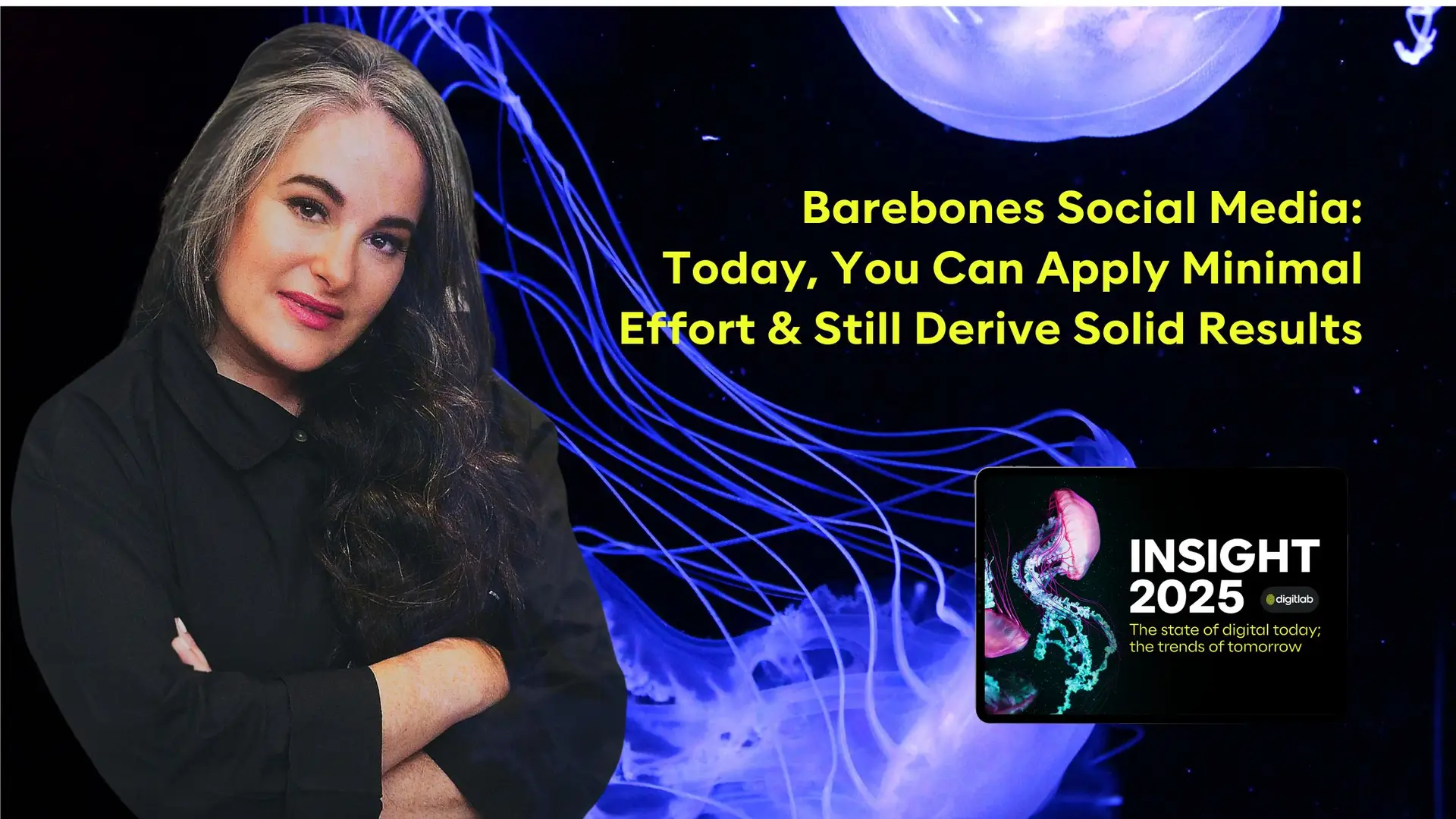We’re excited to feature another expert voice from our Insight 2025 report! This time, Tiffany Markman—renowned copywriter, trainer, and speaker—shares her unconventional approach to social media. Tiffany’s candid reflections and actionable strategies offer a refreshing take on navigating social media without letting it dominate your life. Whether you love it, hate it, or fall somewhere in between, her advice is a must-read for marketers and professionals alike.
I hate social media. I’m not joking. I hate it.
X, formerly Twitter, is a maelstrom of noise and rage and, as for the others, they’re designed largely to manipulate us. That’s why I resent every income-producing hour stolen from me by Facebook, Instagram and TikTok. It’s also why my relationship with LinkedIn can best be described as “It’s complicated”.
But I’m also a realist, so I accept that – if I’m going to continue make my living in marketing, advertising and corporate education – social media is a necessary evil. Like children’s birthday parties, compiling VAT returns and going to the dentist.
Of course, I have a survival strategy for social media (if not for children’s birthday parties): I invest the least time, effort and energy I can get away with in order to yield the best possible results. And you can too. Because the world has changed.
What do I mean by that? How come less can mean more? Consider this:
- Social media algorithms are more sophisticated, so they better understand user preferences and deliver high-quality, relevant content more efficiently.
- The people in our communities are more savvy. They prefer authentic, meaningful engagement to frequent, generic posts.
- Content scheduling (and AI, if that’s your jam) can make it easier, quicker and more seamless to run campaigns, analyse data and be consistent.
- It’s not only easy to re-purpose well-performing content across different platforms and channels – doing so proves to be better for results.
And yet, I can hear what you’re thinking…
If you already follow me on social media, you’re thinking, “Bullsh**t, Tiffany. No one who posts that often hates it that much and no-one with as many opinions as yours can claim to apply minimum effort.”
I do and I can. But I have secrets and you can have them too. Given that the world has changed, there are 5 no-brainers when it comes to barebones social media.
1. Be selective about your platform choices
You don’t have to be everywhere. It’s not an all-or-nothing game. It’s a “fish where the fish are” game. Like dating.
To get the right attention from people who will actually give you work, you must be where they are and focus all your efforts there. Decide where your most desirable audience spends the most time, and invest there. Only there. At least, to start with.
For example
- Let’s say you’re a B2B service provider in the investment space. LinkedIn. YouTube. No need to be on TikTok.
- Let’s say you’re a fashion retailer, known for custom items. Instagram. TikTok. LinkedIn’s not for you.
- Let’s say you’re in food services, FMCGs, ecommerce or convenience. X. Facebook. YouTube is going to be a big commitment.
2. Be deliberate about your themes and topics
Define your objectives. Based on who your fish are, what do you want to get out of your investment of intellectual and emotional bandwidth?
Do you want your audience to know that you’re a specialist in generative AI? That you’re an expert when it comes to building sales funnels for online courses? Or that your ESG knowledge – for multinational corporations – is next-level?
If so, whichever-it-is would be your primary theme and you’d create and share content about and around this area, to seize interest from the right fish. Going one or two levels deeper, you’d also define specific topics and sub-topics this way.
For example
Let’s say you’re the AI specialist. Your objective is to get paid to teach in-house comms and marketing teams to leverage generative AI. Your primary theme, for now at least, is De-Mystifying Generative AI. Your content should be tutorial in nature: how tos, listicles, hot tips, hacks, etc. And your topics could include:
- How to word a perfect prompt under pressure
- What you don’t know about AI
- Who owns the IP when you use AI?
Going further down the rabbit-hole, you might cover:
- How to word a perfect prompt under pressure
- What you don’t know about citing AI sources in your research
- Who owns the IP that’s inside your AI prompts?
3. Pre-schedule the vast majority of your posts
If you don’t derive joy (thanks, Marie Kondo) from social media, you’re going to want to give it as little of your available resources as you can. But given what a time-suck social media can be, you need a system.
For example
My system is Sunday afternoons. A weekly slice of life dedicated to 2 hours of thinking, writing (and image-sourcing), and pre-scheduling, so I don’t have to go onto social media much during the week. There are, of course, parameters:
- I have a 1-page social media content strategy.
- I have content rules for each day of the week, across my 5 key platforms.
- I have an always-on folder for “Social media fodder”, which is the receptacle for ideas, drafts, curated content and bits of training courses.
- I have a social media management tool (that I pay for) to publish my content at certain times, on certain days, with certain rules.
- I use ad hoc “down time” to respond to real-time engagement, like comments, DMs, questions, meaningful tags, etc.
This means that I can spend the bulk of the work-week doing my actual job, without thinking too hard about my social media obligations.
Your own plan may be 10 minutes a day, 20 minutes every other day or 2 hours a week – whatever your appetite and schedule dictates. It may be weekends or weekdays, mornings or nights, in front of the TV or dictated into a notes app. Just find your ideal slot or slots, select your tools of choice and book the time in.
4. Curate good stuff from other top thinkers
At least one out of every four posts I publish is not my original thinking. I curate content from other smart people. (Yes, “curate” is a euphemism for “steal”).
Content curation is more than re-sharing other people’s content. It’s about selecting the best or most thought-provoking content to share, in line with your messaging strategy, and then giving your original take on it.
Sharing solid stuff from big thinkers reflects well on you by association, but it also helps to balance your narrative. This is because it introduces valuable information, insights and IP from within and around your industry.
There are options when curating: You might elevate a piece of content you agree with (or disagree with) – or you might aggregate it, distill it, or mash it up.
Whatever you do, try to put almost as much thought into aligning with your audience as you do when creating content from scratch. And, of course, you must openly credit and link back to the appropriate source.
5. Persist – especially once it’s not fun anymore
There will come a time when you’ve done what I suggest, you’ve seen momentum and you’re feeling good about your investment in social media. But then circumstances or stress will knock you off-course and you’ll start to lose focus.
In your head, this may sound like: “I’ve done social media for 6 weeks and nothing’s happening. This doesn’t work.” Or “It worked. I got busier. But now I’m too busy to do social media marketing.” Or “People are horrible. I hate everyone. Social media is hell.” Or even “I’m talking into a black hole. No one is listening.”
If you’re serious about social media self-promotion, don’t allow yourself to lose your way. Don’t stop when it becomes a pain in the ass, because that’s usually the tipping point. Get straight back into it. Without thinking, if possible. It takes a good few months – I’d say, 6-9 – to really see the returns that are possible.
WHAT’S THE BOTTOM LINE?
If you want to be able to invest the least effort possible, but still get optimal social media results, you’ll need to go further than your comfort zone. At least, at first. Thereafter, you’ll be able to do the minimum you can tolerate – if you do it consistently and over time.
Going back to the necessary evil that is the children’s birthday party, you’ll need to show up. And it’ll be noisy and sticky and chaotic. But you only have to stay until cake time.
You can read more from our other contributors and download the full report here: Digital Trends Report






